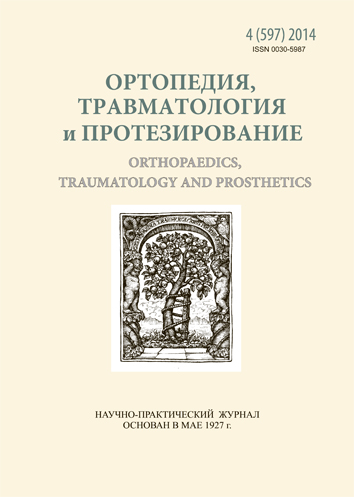Rebuilding of bone tissue around titanium implants after application of low-intensity pulsed ultrasound at different stages osteoreparation (experimental study)
DOI:
https://doi.org/10.15674/0030-59872014447-55Keywords:
low-pulsed ultrasound, titanium implant, rat femur, histological studyAbstract
to perform a comparative analysis of the structural organization of the femur with titanium implant in rats after exposure to pulsed ultrasound with intensity 0.4 W/cm2 applied at different stages of osteoreparation. Methods: In 20 rats six months of age (group 1) effect of ultrasound (10 sessions 5 min) we started from the 3rd day after the implantation of titanium samples (BT 16), i.e. at the end stage of traumatic inflammation, and in the remaining 20 animals (group 2) — on the 7th day, at the stage of tissue structures regenerate formation and differentiation of different types of connective tissue. The animals were taken out of the experiment after 7, 14, 30 and 45 days after implantation in terms that correspond to different stages of reparative osteogenesis. Dedicated femur fragments with titanium implants studied by the methods of histology with histomorphometry (thickness of connective tissue capsule around the implant perimeter, area of newly formed tissue around it, the length of the surface of the bone trabeculae occupied by active osteoblasts, the rate of osseointegration, which characterizes the length of the direct contact with the surface of the implant with bone). Results revealed that the use of pulsed ultrasound on the 3rd day after the operation positively influents on the recovery of bone around titanium implants that appears with more active restructuring of granulation tissue to fibroretykular and bone in the early stages of osteoreparation, and determines on the later stages faster formation of mature bone with plate structure than in the case of ultrasound using on the 7th day. On the 45th day of the study it was not found expressed preferences between the groups according to bone morphometric parameters while osseointegration rate in group 1 was 7.5 % higher than in the second. Thickness of dense connective tissue formed on the edge of contact with the implant in all periods of observation was lower in animals of group 1.
References
- Della Rocca G. J. The science of ultrasound therapy for fracture healing / G. J. Della Rocca // Indian. J. Orthop. — 2009. — Vol. 43 (2). — Р. 121–126.
- Effects of near-field ultrasound stimulation on new bone formation and osseointegration of dental titanium implants in vitro and in vivo / S. K. Hsu, W. T. Huang, B. S. Liu [et al.] // Ultrasound Medю Biol. — 2011. — Vol. 37 (3). — P. 403–416. doi: 10.1016/j.ultrasmedbio.2010.12.004.
- Emami A. No effect of low-intensity ultrasound on healing time of intramedullary fixed tibial fractures / A. Emami, M. Petren-Mallmin, S. Larsson // J. Orthop. Trauma. — 1999. — Vol. 13. — P. 252–257.
- Interactions between cells and titanium surfaces / E. Eisenbarth, D. Velten, K. Schenk-Meuser [et al.] // Biomolecular Eng. — 2002. — № 19. — P. 243–249.
- Porous titanium obtained by a new powder metallurgy technique. Preliminary results of human osteoblast adhesion on surface polished substrates / M. Biasotto, R. Ricceri, N. Scuor [et al.] // J. Appl. Biomater. Biomech. — 2003. — Vol. 1 (3). —
- P. 172–177.
- The evidence of low-intensity pulsed ultrasound for in vitro, animal and human fracture healing / M. P. de Albornoz, A. Khanna, U. G. Longo [et al.] // Br. Med. Bull. — 2011. — Vol. 100 (1). — P. 39–57. doi: 10.1093/bmb/ldr006.
- Thull R. Physicochemical principles of tissue material interactions / R. Thull // Biomolecular Еng. — 2002. — № 19. — P. 43–50.
- Ultrasound for fracture healing: current evidence / Y. Watanabe, T. Matsushita, M. Bhandari [et al.] // J. Orthop. Trauma. — 2010. — Vol. 24, Suppl. 1. — P. S56–S61. doi: 10.1097/BOT.0b013e3181d2efaf.
Downloads
How to Cite
Issue
Section
License
Copyright (c) 2014 Svitlana Malyshkina, Vasyl Makolinets, Olga Nikolchenko, Tamara Grashchenkova, Gennady Ivanov

This work is licensed under a Creative Commons Attribution 4.0 International License.
The authors retain the right of authorship of their manuscript and pass the journal the right of the first publication of this article, which automatically become available from the date of publication under the terms of Creative Commons Attribution License, which allows others to freely distribute the published manuscript with mandatory linking to authors of the original research and the first publication of this one in this journal.
Authors have the right to enter into a separate supplemental agreement on the additional non-exclusive distribution of manuscript in the form in which it was published by the journal (i.e. to put work in electronic storage of an institution or publish as a part of the book) while maintaining the reference to the first publication of the manuscript in this journal.
The editorial policy of the journal allows authors and encourages manuscript accommodation online (i.e. in storage of an institution or on the personal websites) as before submission of the manuscript to the editorial office, and during its editorial processing because it contributes to productive scientific discussion and positively affects the efficiency and dynamics of the published manuscript citation (see The Effect of Open Access).














